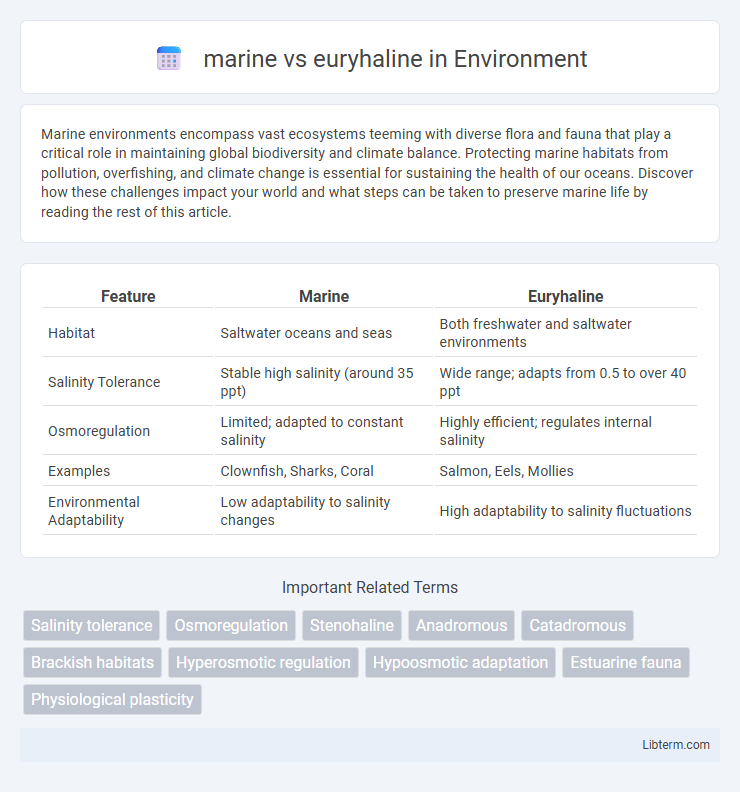Marine environments encompass vast ecosystems teeming with diverse flora and fauna that play a critical role in maintaining global biodiversity and climate balance. Protecting marine habitats from pollution, overfishing, and climate change is essential for sustaining the health of our oceans. Discover how these challenges impact your world and what steps can be taken to preserve marine life by reading the rest of this article.
Table of Comparison
| Feature | Marine | Euryhaline |
|---|---|---|
| Habitat | Saltwater oceans and seas | Both freshwater and saltwater environments |
| Salinity Tolerance | Stable high salinity (around 35 ppt) | Wide range; adapts from 0.5 to over 40 ppt |
| Osmoregulation | Limited; adapted to constant salinity | Highly efficient; regulates internal salinity |
| Examples | Clownfish, Sharks, Coral | Salmon, Eels, Mollies |
| Environmental Adaptability | Low adaptability to salinity changes | High adaptability to salinity fluctuations |
Defining Marine and Euryhaline Organisms
Marine organisms inhabit stable saltwater environments, typically oceans and seas, with consistent salinity levels around 35 ppt. Euryhaline organisms possess the remarkable ability to survive in a wide range of salinities, from freshwater to full-strength seawater, adapting through osmoregulatory mechanisms. This physiological adaptability distinguishes euryhaline species from strictly marine species, enabling survival in estuaries, tidal zones, and brackish waters.
Habitat Differences: Oceans vs Variable Waters
Marine species are adapted exclusively to stable oceanic environments with consistent salinity levels around 35 ppt, thriving in saltwater habitats such as coral reefs and open seas. Euryhaline species exhibit remarkable osmoregulatory capabilities, allowing them to inhabit variable waters including estuaries, brackish lagoons, and tidal zones where salinity fluctuates dramatically between freshwater and marine conditions. This physiological flexibility enables euryhaline organisms like salmon and mangrove crabs to migrate and survive across diverse aquatic ecosystems that marine species cannot tolerate.
Salinity Tolerance and Adaptation Mechanisms
Marine organisms exhibit narrow salinity tolerance, thriving primarily in stable oceanic conditions with salinity around 35 ppt, relying on osmoregulatory mechanisms to maintain internal ionic balance. Euryhaline species demonstrate broad salinity tolerance, capable of surviving in environments ranging from freshwater to hypersaline waters by dynamically adjusting their osmoregulatory processes, such as altering ion transport and cellular permeability. Adaptation mechanisms in euryhaline organisms include specialized gill ionocytes and renal functions that facilitate efficient salt excretion or uptake, enabling rapid acclimation to fluctuating salinity levels.
Osmoregulation Strategies in Marine Species
Marine species predominantly employ osmoregulation strategies such as active ion transport and water excretion to maintain internal salt balance in hyperosmotic seawater environments. In contrast, euryhaline species possess adaptable osmoregulatory mechanisms enabling them to regulate osmotic pressure across varying salinities, often switching between ion uptake and secretion depending on whether they inhabit freshwater or marine habitats. These physiological adaptations involve specialized cells in gills, kidneys, and integument that facilitate ion exchange and water balance critical for survival in fluctuating salinity conditions.
Euryhaline Adaptations: Thriving in Fluctuating Environments
Euryhaline species possess unique physiological adaptations such as efficient osmoregulatory mechanisms that allow them to maintain cellular homeostasis across varying salinities, enabling survival in both marine and freshwater environments. Their gills, kidneys, and hormonal systems dynamically adjust ion exchange and water retention to cope with rapid changes in salinity. These adaptations contrast with strictly marine species, which are typically limited to stable saline conditions and lack the flexibility to thrive in fluctuating environments.
Examples of Marine vs Euryhaline Organisms
Marine organisms such as clownfish (Amphiprioninae) and blue tangs (Paracanthurus hepatus) thrive exclusively in stable saltwater environments, unable to tolerate significant salinity changes. Euryhaline species like the Atlantic salmon (Salmo salar) and the Mozambique tilapia (Oreochromis mossambicus) adapt to varying salinities, migrating between freshwater and marine ecosystems during their life cycles. These adaptive capabilities allow euryhaline fish to colonize estuaries and coastal waters, environments inhospitable to strictly marine species.
Ecological Roles and Importance in Aquatic Ecosystems
Marine species primarily inhabit stable saltwater environments, playing crucial roles in nutrient cycling, habitat structuring, and supporting complex food webs in oceans. Euryhaline organisms tolerate wide salinity fluctuations, enabling them to bridge freshwater and marine ecosystems, facilitating energy transfer and maintaining biodiversity in estuaries and coastal zones. Their ecological adaptability supports resilience in dynamic habitats, contributing to the stability and productivity of aquatic ecosystems.
Challenges Faced by Marine and Euryhaline Life
Marine organisms struggle with stable but high salinity levels, requiring efficient osmoregulation to prevent dehydration. Euryhaline species encounter fluctuating salinity conditions, demanding versatile physiological adaptations to survive abrupt changes in salinity. Both face challenges in maintaining ionic balance and cellular function amid variable environmental stresses.
Human Impact on Marine and Euryhaline Habitats
Human activities such as coastal development, pollution, and overfishing have severely impacted marine habitats, leading to habitat loss and reduced biodiversity. Euryhaline species, which tolerate a broad range of salinities, face challenges from altered salinity gradients caused by freshwater withdrawals and climate-induced sea-level rise. Conservation efforts must address these pressures to protect the ecological balance and sustain both marine and euryhaline ecosystems.
Future Research Directions on Salinity Adaptation
Future research directions on salinity adaptation emphasize genomic and transcriptomic analyses to uncover molecular mechanisms in marine and euryhaline species. Studies increasingly focus on identifying key osmoregulatory genes and pathways that enable euryhaline organisms to tolerate fluctuating salinities. Advanced biotechnologies, including CRISPR and epigenetic profiling, are being applied to enhance understanding of evolutionary adaptations and potential applications in aquaculture under changing environmental salinity regimes.
marine Infographic

 libterm.com
libterm.com